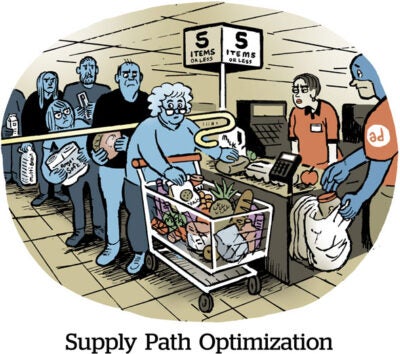In a year marked by cautious advertiser spending due to persistent economic uncertainty, supply path optimization (SPO) was a major priority for marketers.
In 2022, SPO solutions largely revolved around creating direct connections to so-called premium publishers.
But machine learning (ML) and artificial intelligence (AI) also took on a bigger role in SPO this year. Vendors created custom algorithms designed to optimize spending toward media proven to drive a brand’s chosen KPIs.
And 2022 was the year the ad industry began touting SPO as the solution of choice for sustainability-focused marketers. Instead of just maximizing return on ad spend, marketers can cut down on the emissions produced by programmatic advertising’s duplicate ad calls.
Direct connections
The Trade Desk (TTD) dominated the SPO conversation this year with the debut of OpenPath in February. Through OpenPath, publishers could work directly with the DSP (through a Prebid adapter, for example) without having to go through SSPs. As of May, TTD said the solution has added direct connections to more than 100 premium publishers.
While OpenPath found plenty of supporters, its critics accused TTD of encroaching on SSPs’ territory and saw the move as a threat to cut SSPs out of the supply chain entirely. TTD was also accused of abandoning its exclusive commitment to advertisers, with its publisher-facing efforts painted as a conflict of interest in how it serves the buy side.
TTD’s decision to turn off Google Open Bidding, which lets SSPs compete against Google AdX inside Google’s ad server, showed that SPO could be used not just for efficiency but as a tool to undermine Google’s ubiquity. Other DSP providers like Yahoo and Amobee followed TTD’s lead and cut ties with Google Open Bidding.
But despite these fears, OpenPath has not completely transformed the supply chain just yet, and SSPs are still kicking.
TTD isn’t the only major player in ad tech pushing SPO solutions that revolve around direct publisher connections. GroupM made headlines this year with the rollout of its Premium Marketplaces offering, which offered more direct connections with publishers in partnership with PubMatic and Magnite.
SPO is also taking over the ascendant CTV channel. For example, both PubMatic and Magnite announced CTV-focused direct partnerships with Horizon Media in November.
SPO and sustainability
While the SPO conversation has historically centered on driving down costs for advertisers, a new talking point emerged in 2022: the need to drive down emissions generated by programmatic bidding.
“Our partners are thinking about the most strategic investments for lowering carbon [emissions] within the media supply chain,” said Christine Foster, VP of media operations at Kroger Precision Marketing, at AdExchanger’s Programmatic IO event in October.
Programmatic buying requires massive computing power. With impressions often resold by ad tech intermediaries or offered by multiple SSPs, there is plenty of waste that could be cut by intelligent SPO solutions or by creating more direct paths to inventory.
“There’s a real-world cost to buying through 10 supply paths rather than one supply path for the same inventory,” said Krzysztof Franaszek, founder of Adalytics. “People have a moral and economic imperative to consider those costs.”
Most ad agencies aim for 80% viewability. But having 20% of all ads rendering below the fold produces about 27,000 metric tons of carbon a year. If agencies raised their viewability standards by 10%, those wasteful emissions could be cut in half, said Scope3 co-founder and CEO Brian O’Kelley in October at Programmatic IO.
Custom bidding algorithms aren’t always explicitly positioned as SPO solutions. But as the viewability example shows, fine-tuning bidding can make a brand’s buying decisions more efficient and sustainable. For example, it’s possible to design a custom bidding algorithm that places higher bids on inventory with a high attention score.
Bidding algorithms can also use publishers’ and vendors’ carbon emissions as a signal for identifying greener supply paths. Buyers can now consider not just optimizing away from inefficient supply chains but working with more green vendors and minimizing their own carbon emissions.
So, as we head into 2023, look for sustainability to become an even bigger part of the SPO discussion.

















